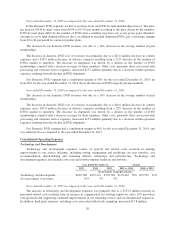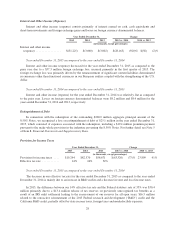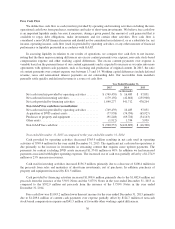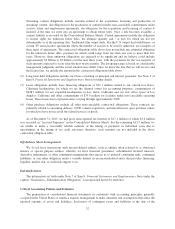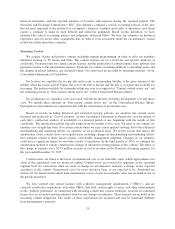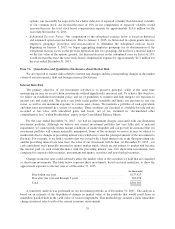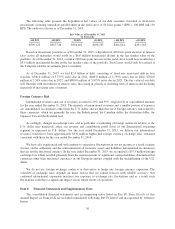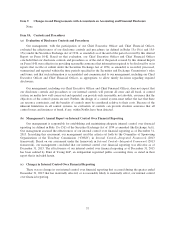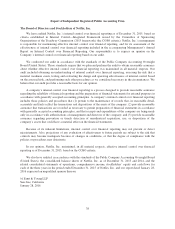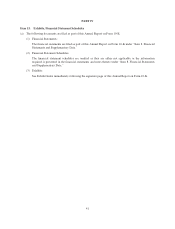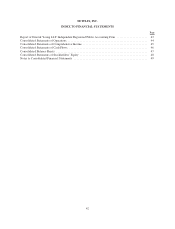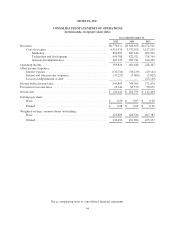NetFlix 2015 Annual Report Download - page 39
Download and view the complete annual report
Please find page 39 of the 2015 NetFlix annual report below. You can navigate through the pages in the report by either clicking on the pages listed below, or by using the keyword search tool below to find specific information within the annual report.
options, can reasonably be expected to be a better indicator of expected volatility than historical volatility
of our common stock. An increase/decrease of 10% in our computation of expected volatility would
increase/decrease the total stock-based compensation expense by approximately $10.6 million for the
year ended December 31, 2015.
•Suboptimal Exercise Factor: Our computation of the suboptimal exercise factor is based on historical
and estimated option exercise behavior. Prior to January 1, 2015, we bifurcated its option grants into two
employee groupings (executive and non-executive) to determine the suboptimal exercise factor.
Beginning on January 1, 2015, we began aggregating employee groupings for its determination of the
suboptimal exercise factor as the previous bifurcation into two groupings did not have a material impact
on the fair value of the options granted. An increase/decrease in the suboptimal exercise factor of 10%
would increase/decrease the total stock-based compensation expense by approximately $4.3 million for
the year ended December 31, 2015.
Item 7A. Quantitative and Qualitative Disclosures about Market Risk
We are exposed to market risks related to interest rate changes and the corresponding changes in the market
values of our investments, debt and foreign currency fluctuations.
Interest Rate Risk
The primary objective of our investment activities is to preserve principal, while at the same time
maximizing income we receive from investments without significantly increased risk. To achieve this objective,
we follow an established investment policy and set of guidelines to monitor and help mitigate our exposure to
interest rate and credit risk. The policy sets forth credit quality standards and limits our exposure to any one
issuer, as well as our maximum exposure to various asset classes. We maintain a portfolio of cash equivalents
and short-term investments in a variety of securities. These securities are classified as available-for-sale and are
recorded at fair value with unrealized gains and losses, net of tax, included in “Accumulated other
comprehensive loss” within Stockholders’ equity in the Consolidated Balance Sheets.
For the year ended December 31, 2015 , we had no impairment charges associated with our short-term
investment portfolio. Although we believe our current investment portfolio has very little risk of material
impairment, we cannot predict future market conditions or market liquidity and can provide no assurance that our
investment portfolio will remain materially unimpaired. Some of the securities we invest in may be subject to
market risk due to changes in prevailing interest rates which may cause the principal amount of the investment to
fluctuate. For example, if we hold a security that was issued with a fixed interest rate at the then-prevailing rate
and the prevailing interest rate later rises, the value of our investment will decline. At December 31, 2015 , our
cash equivalents were generally invested in money market funds, which are not subject to market risk because
the interest paid on such funds fluctuates with the prevailing interest rate. Our short-term investments were
comprised of corporate debt securities, government and agency securities and asset backed securities.
Changes in interest rates could adversely affect the market value of the securities we hold that are classified
as short-term investments. The table below separates these investments, based on stated maturities, to show the
approximate exposure to interest rates as of December 31, 2015.
(in thousands)
Due within one year .............................................. $137,927
Due after one year and through 5 years ............................... 363,458
Total .......................................................... $501,385
A sensitivity analysis was performed on our investment portfolio as of December 31, 2015 . The analysis is
based on an estimate of the hypothetical changes in market value of the portfolio that would result from an
immediate parallel shift in the yield curve of various magnitudes. This methodology assumes a more immediate
change in interest rates to reflect the current economic environment.
35



